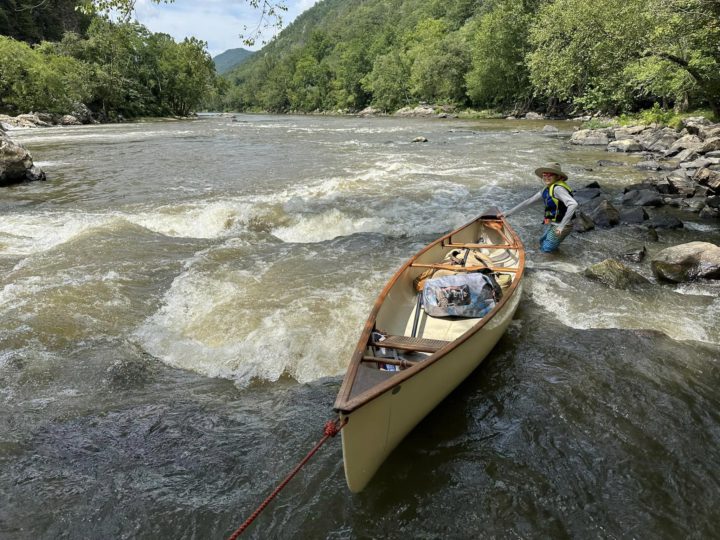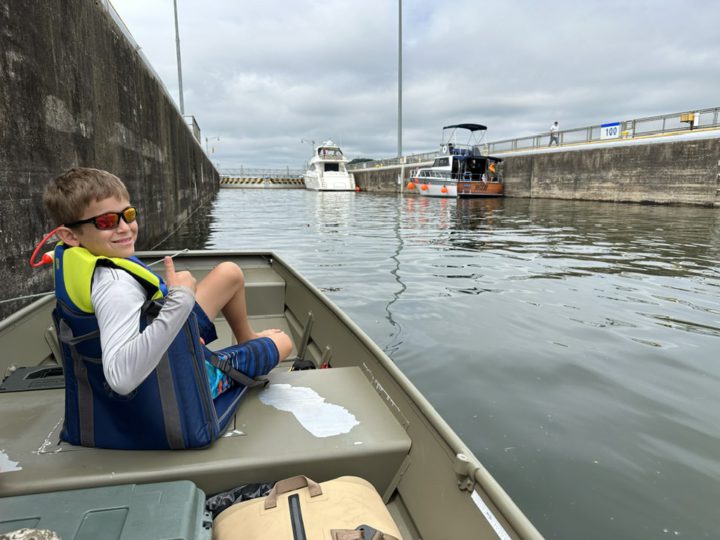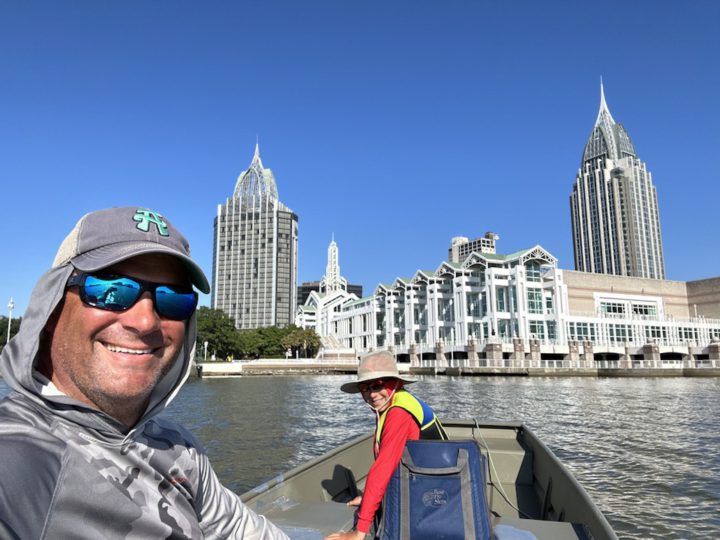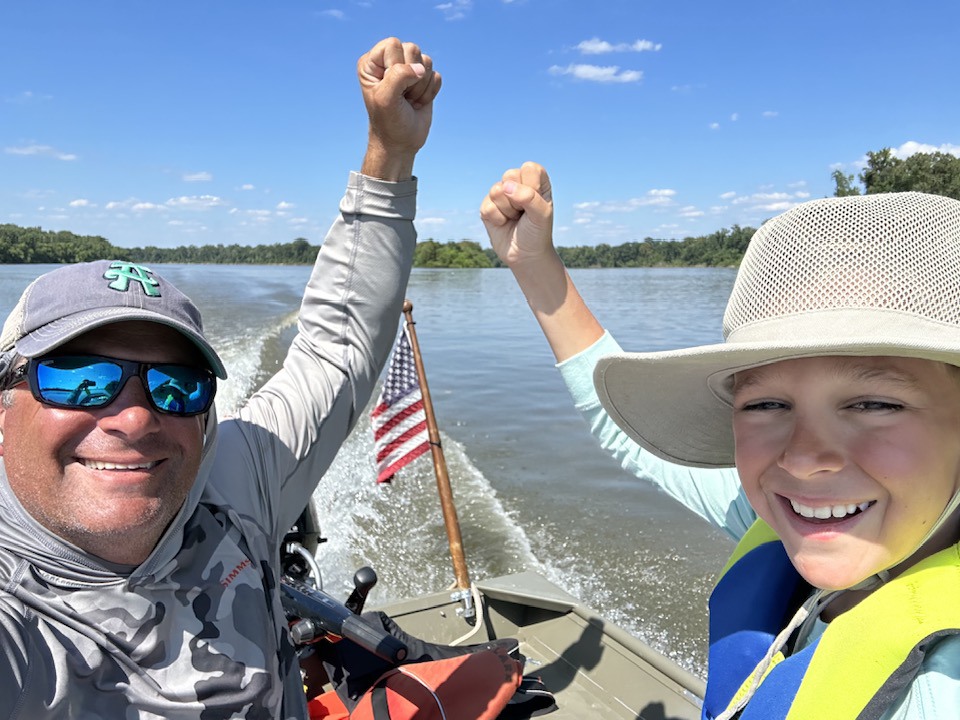East Asheville resident Clark Glenn has always loved rivers.
As a kid growing up in Mobile, Ala., he spent hours studying the waterways prominently displayed on the state seal. He spent even more time in boats. “Every summer of my childhood from Memorial Day to Labor Day, I was on the water of Mobile Bay,” he says. “It’s in my bones.”
In 1984, his father took him to the grand opening of the Tennessee-Tombigbee Waterway, a U.S. Army Corps of Engineers project that runs 234 miles, connecting the Tennessee River in northeast Mississippi with the Tombigbee River near Demopolis, Ala. In Mobile, Glenn explains, residents refer to it as Tenn-Tom. During the grand opening event, Glenn leaned over to his father and said, “One day I’m going to run the Tenn-Tom in a boat.”
Nearly 40 years later, Glenn revisited the idea — albeit with a new twist. Rather than simply traverse the Tenn-Tom, he decided to start from the Swannanoa River and travel by water to the Gulf of Mexico, using a canoe and a johnboat in a piecemeal fashion he calls “Huck-Finning it.” His 11-year-old son, Taber, would be his first mate.
In February, the two visited Clark’s hometown for Taber’s first Mardi Gras. At a spot overlooking Mobile Bay, Clark explained to his son the link between Western North Carolina and the spot where they were standing. “There’s a drop of water from Snake Creek right here,” he told Taber, referring to a stream on their property in East Asheville. “Why don’t we leave from our front door, and we’ll go the whole way?”
Safety first
The idea wasn’t as crazy as it sounds.

A former sea kayak and whitewater instructor, Clark has plenty of experience working on rivers as well as making them settings for grand adventures. When he was the director of outdoor programs at The Lawrenceville School in New Jersey, he built a kayak out of mahogany and paddled from his house to Baltimore’s Inner Harbor.
To prepare for the trip to Mobile, Clark took his son to Swannanoa’s Charles D. Owen Park and taught him canoe paddle strokes before they set off on their adventure on Aug. 7. Staying true to the original vision, they started walking from their front door with backpacks on. They crossed U.S. 70 and headed west along the railroad tracks until they reached Porters Cove Road, where Glenn’s fiancée, Lisa Greenberg, met them with the canoe.
Greenberg served as their support team for the first three days of the trip and was forced into duty just a few hours after Clark and Taber started paddling down the Swannanoa River. A storm hit, and the weather forecast said there was going to be heavy rain, 40 mph winds and possible tornadoes for the next 5 1/2 hours. Clark and Taber were in a narrow, steep-walled section of the river — not a place you want to be during a flood. Greenberg picked them up and took them to a nearby Cracker Barrel, where they enjoyed hot chocolate and French toast while the rain blew sideways against the windows.
Glenn’s other concession to safety came on the second day of the trip, when he chose to raft Section 9 of the French Broad River with French Broad Adventures instead of braving its Class III and IV rapids in a canoe. Later, he and Taber ran several smaller rapids in their canoe up near Hot Springs. But for subsequent larger ones, they “lined” the canoe, guiding it down the river with a rope while walking along the bank.
Once they completed the French Broad rapids, Greenberg picked them up near Newport, Tenn. From there, they swapped the canoe for a johnboat. Clark estimated paddling to Mobile would have taken two months, time they did not have.
They launched their latest vessel near Kodak, Tenn., where Clark and his son enjoyed a cruising speed of 20 mph, until Taber identified a problem. “I can see water splashing up,” he said, pointing. “I think it’s a rapid.”
Unlike with a canoe, there is no way to line a johnboat. “Once it’s in the water, it’s in the water,” Clark explains.
Idling the boat with its bow pointed upstream, Clark scouted the rapid, readied their throw bag and discussed a safety plan with Taber. Fortunately, Clark found a path through the rapid he felt good about, lifted the johnboat’s 110-pound motor out of the water and ran it cleanly.
Educational opportunities on the Tennessee River
Downriver from Kodak, the Holston River joins the French Broad, and their confluence forms the Tennessee River. “On a lot of these rivers, when they come together and you have a new name for a river, there’s generally a distinctive change in the feeling of the river,” Clark says. “When a river’s name changed, you felt like you were in a different place.”
Clark estimated the Tennessee River was 400-500 yards wide at this point in their journey. Compared to the French Broad, it also had more of an industrial feel. They had to share the river with commercial traffic, which Clark found comforting. “A lot of these sections of river are very remote, so any traffic is a welcome thing,” he says.

Clark used the sight of other boats as an opportunity to teach his son about river culture. “Almost every single boat waves to each other,” he explained to Taber. “You’re not only saying hello to people, you’re also acknowledging that you’re OK.”
Another educational opportunity arose when they encountered the first of the 18 locks they would need to navigate on their trip. Locks raise and lower boats between sections of rivers that have different water levels. The night before they arrived at Fort Loudon Lock, Clark called its operator, who instructed him to call back when they were 15 minutes out so he could prepare the lock for them.
Six hundred feet long and 110 feet wide, the locks on the Tennessee River can fit as many as eight barges, and the entire process, from entering a lock to exiting it, usually takes 30-45 minutes. Glenn used that time to give his son engineering lessons. “We were able to talk about the mathematics of the distances we were falling in the locks and figure out their volume,” he recalls. “Locks are fascinating because they have these massive doors and these massive volumes of water, but it’s actually a very simple system.”
Traveling on fumes
As Clark and Taber entered the heart of their journey, they faced a series of challenges. Multiple storms forced them to seek shelter at various locations, including a Sonic in South Pittsburg, Tenn., and an abandoned dock west of Decatur, Ala.
They also experienced several mechanical issues. As they entered Guntersville Lake near Huntsville, Ala., the johnboat’s motor suddenly quit on them. Clark waved down “two angels from northern Alabama,” who loaned them the socket wrench they needed to fix the problem and gave Taber candy bars and a Gatorade.
Even more frustrating, eelgrass continually clogged the johnboat’s cooling water intake while they crossed the 75-mile-long lake.
After nearly traversing the entire width of Alabama on Aug. 13, they arrived in Florence at sunset. They had hoped to get to Florence Harbor Marina, but it was on the other side of Wilson Lock, which, at 94 feet, is the highest lift lock east of the Rocky Mountains. It also has a reputation for being one of the Tennessee River’s busier and slower locks, so it was a disappointment, but not a surprise, when its operator told Glenn there was a 3 1/2-hour wait and they should come back at 6 a.m.
Taking a chance, they left their johnboat at the public boat ramp and hitched a ride to a hotel. They awoke at 4:30 a.m. and finally made their way back to the ramp at 6 a.m., in time to get through Wilson Lock.
On Aug. 14, they crossed into Mississippi and entered the Tenn-Tom, which they followed south until they crossed back into Alabama at Aliceville Lake, where the Tenn-Tom ends and the Tombigbee River begins.
The efficiency of the johnboat’s 15 horsepower, four-stroke engine allowed them to go 22 mph at full throttle while burning a little more than a gallon of gas per hour. They’d started the trip with a 6-gallon tank as well as a 3-gallon tank and along the way bought a 2 1/2-gallon tank as a backup, giving them roughly 10 hours of runtime.
Eager to get to Demopolis, where one of Clark’s high school friends lived, they traveled 177 miles on Aug. 16 before running out of gas 3 miles from their destination. Combining the dregs of all three tanks into one and holding it beneath his arm, Clark was able to restart the motor and get them to the town’s dock on time.
The homestretch
The trip wasn’t all adrenaline and stress. Clark and Taber often stopped to swim, and they enjoyed numerous wildlife sightings. In the French Broad’s whitewater section, they watched a deer casually walk through rapids on its way to an island. On a flatter stretch of the French Broad, they saw two bald eagles fighting; the loser, perhaps injured, used its wings to swim away. They also spotted lots of wild hogs and turkeys as well as a copperhead snake.
There were many cultural highlights as well throughout their stops in Alabama. At the Cochrane Campground in Aliceville, their host family invited them to tag along to pull up trotlines. The first two were empty, but the third held three large catfish, the biggest of which was as long as Taber’s leg. Passing through Epes, they saw its famous Selma chalk formations, Alabama’s version of the White Cliffs of Dover. And in Silas, they stopped at Bobby’s Fish Camp, a marina that’s earned a reputation for serving some of the best fried catfish in the South.

After the Tombigbee River met up with the Alabama River to form the Mobile River, Clark was able to judge the distance to his hometown by the landmarks they passed. First, there was 27 Mile Bluff, which was Mobile’s original location and the first capital of French Louisiana. Then came the General W.K. Wilson Jr. Bridge, known locally as the Dolly Parton Bridge.
Finally, on Aug. 17, 12 days after leaving Asheville, they arrived at the Mobile Convention Center. The trip there from Asheville is about 530 miles by car. Glenn estimated the journey by boat was more than 1,100 miles.
By any measure it was a grand adventure. That he’d done it with his son made it even more so. “He was the best first mate a captain could ever want,” Clark says. “Every day, he got right back into it. He was never bored. Not once.”
Shortly after finishing the journey, Clark called his father to share the news with him. “Remember me telling you I was going to run the Tenn-Tom one day?” he said over the phone.
Glenn’s dad laughed. “Yeah, but I didn’t think you were actually going to do it.”




Before you comment
The comments section is here to provide a platform for civil dialogue on the issues we face together as a local community. Xpress is committed to offering this platform for all voices, but when the tone of the discussion gets nasty or strays off topic, we believe many people choose not to participate. Xpress editors are determined to moderate comments to ensure a constructive interchange is maintained. All comments judged not to be in keeping with the spirit of civil discourse will be removed and repeat violators will be banned. See here for our terms of service. Thank you for being part of this effort to promote respectful discussion.